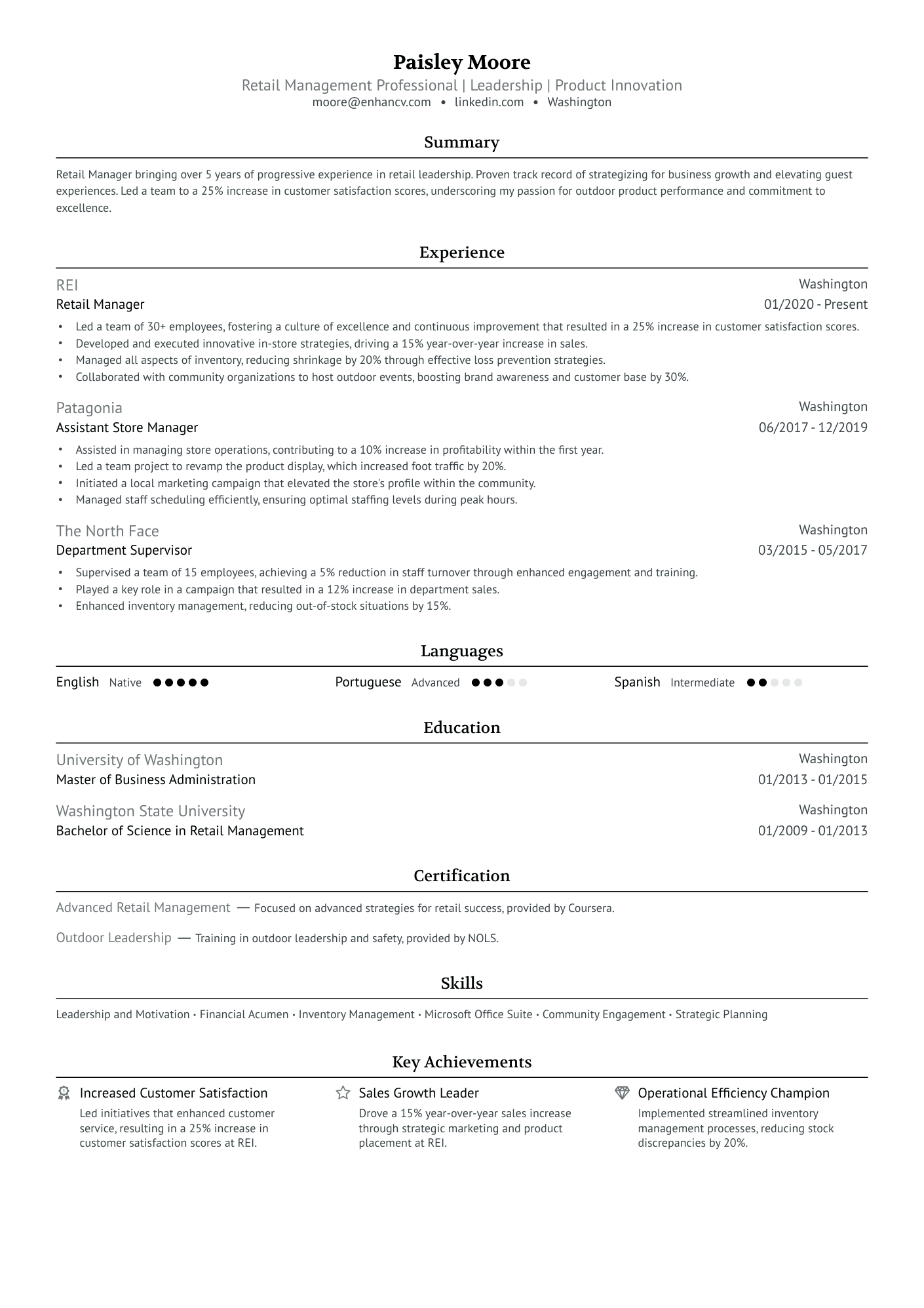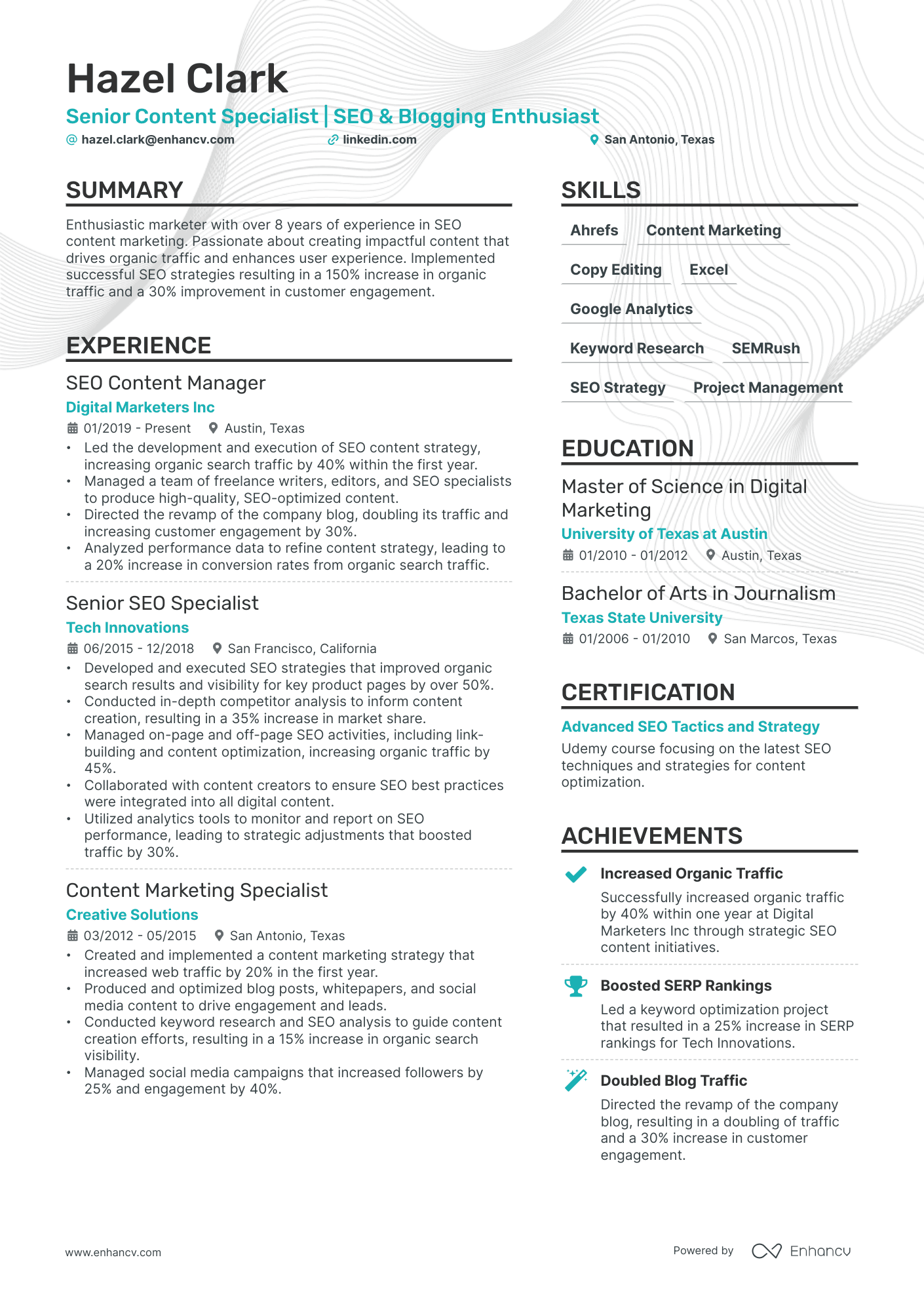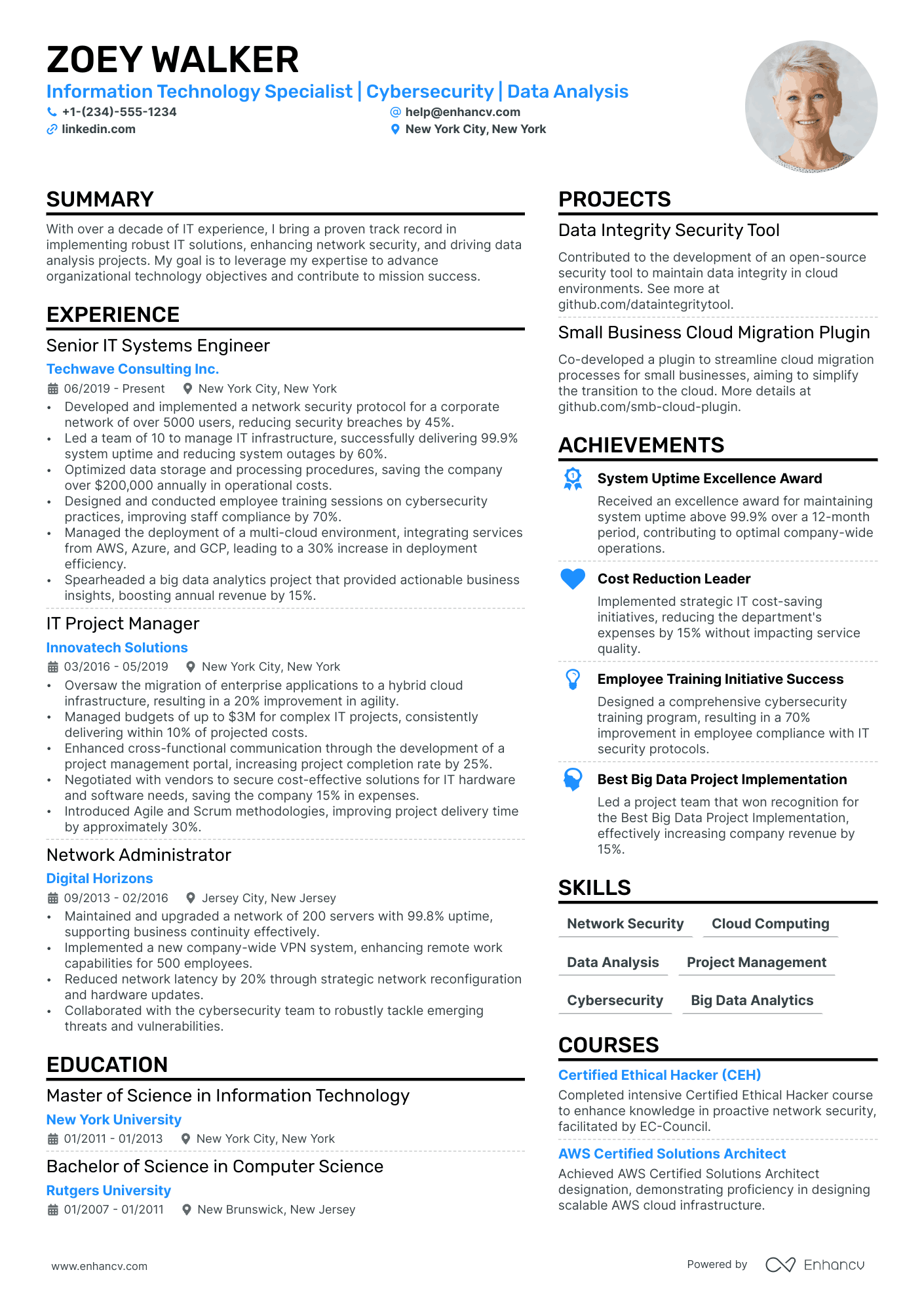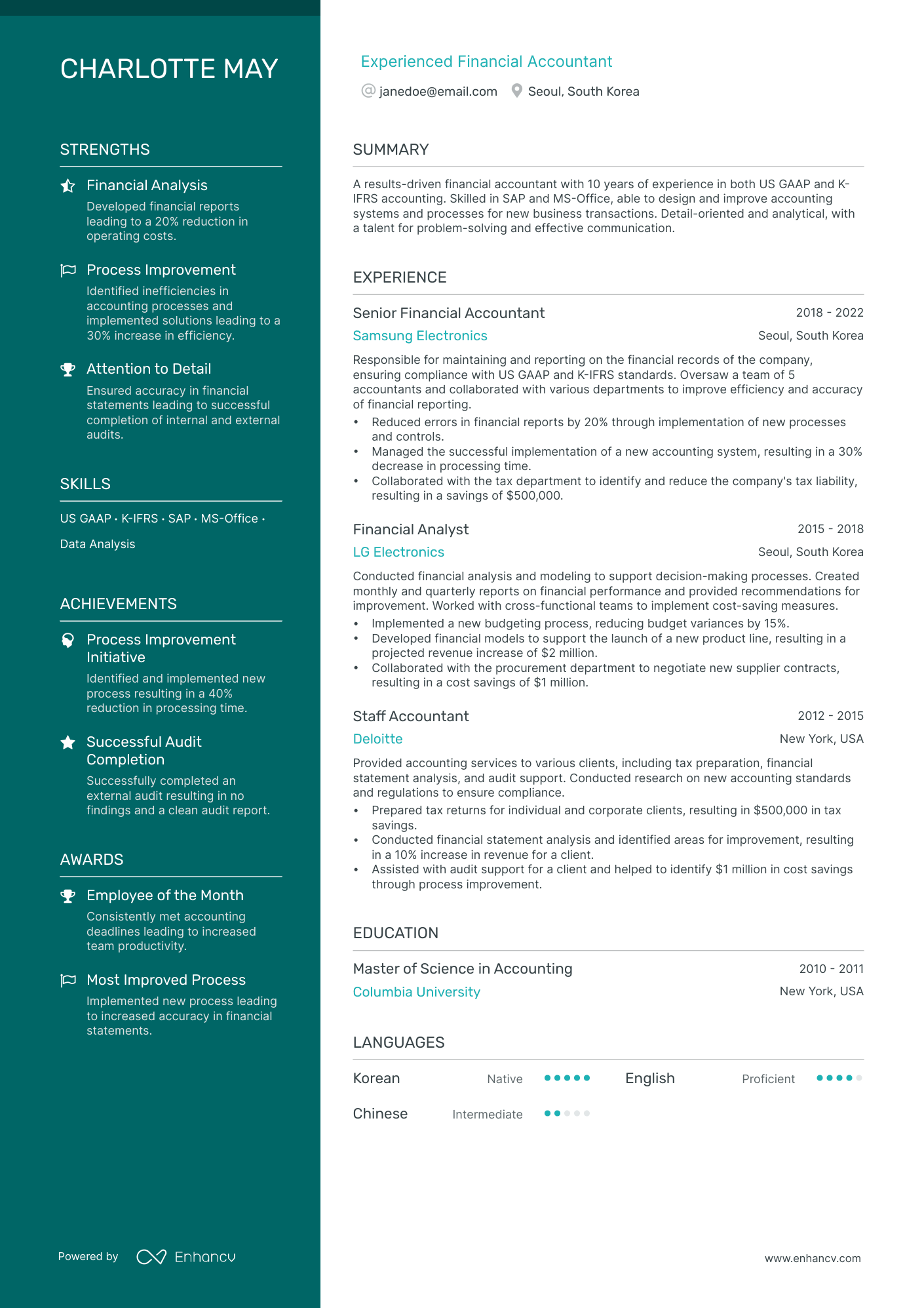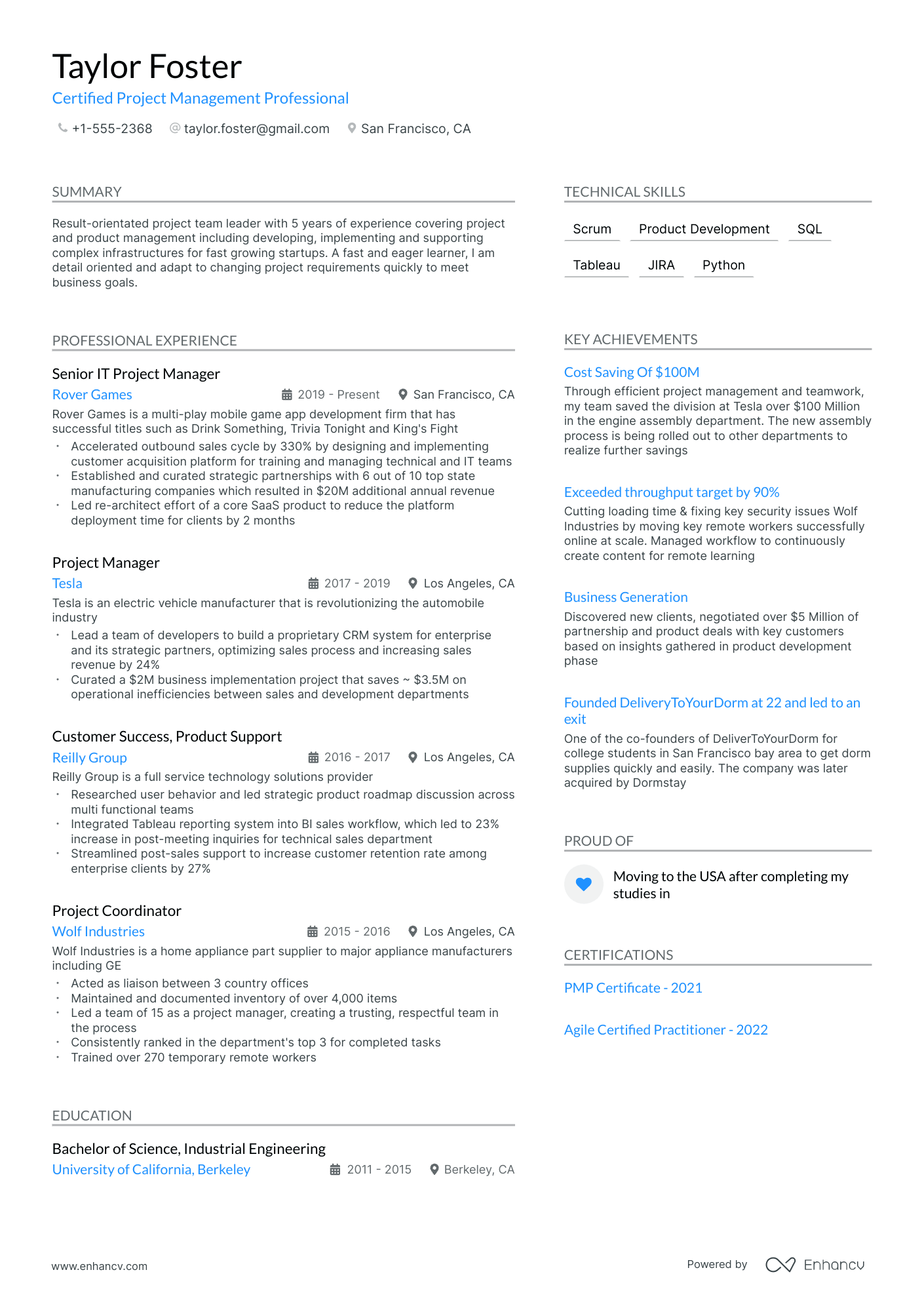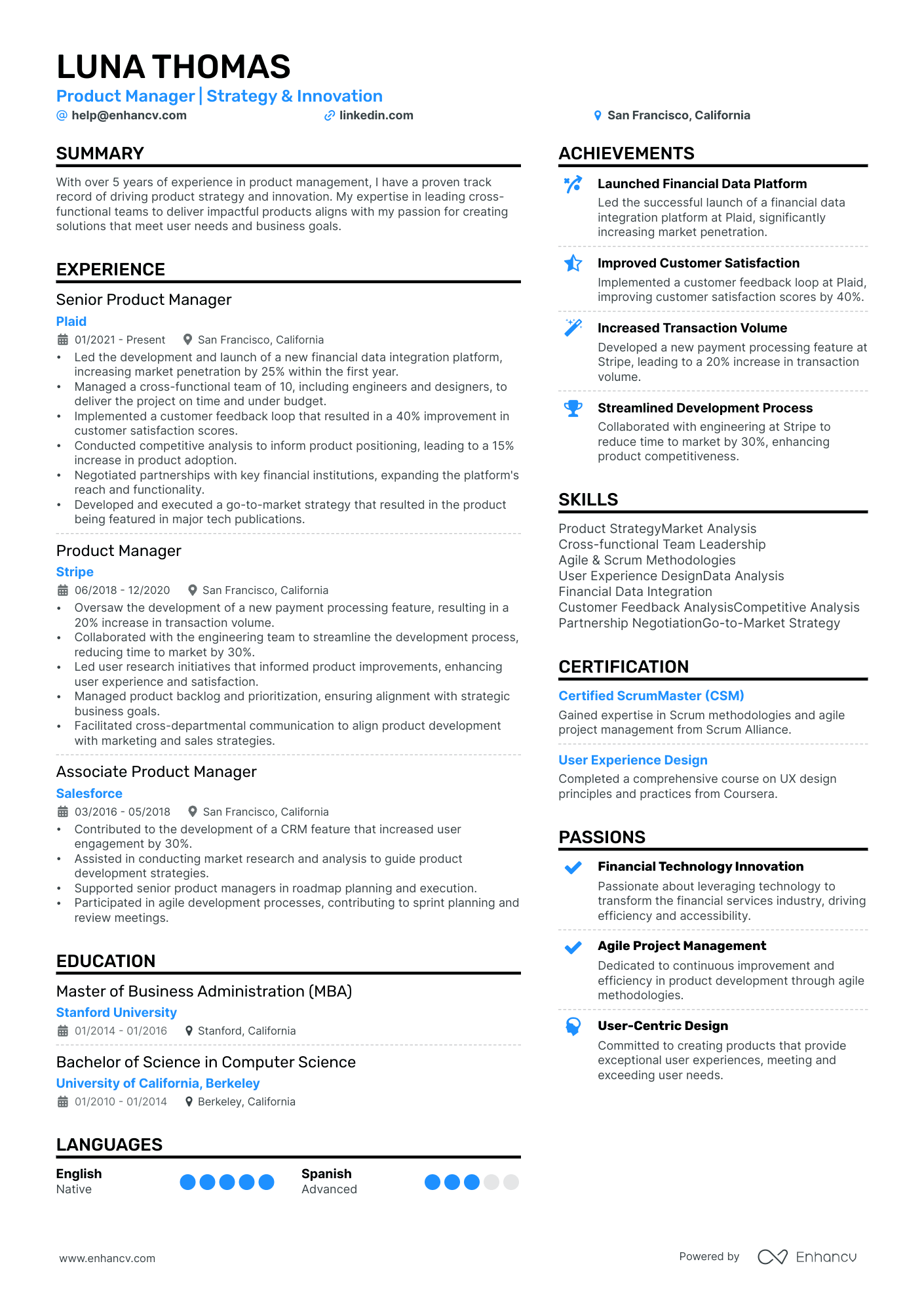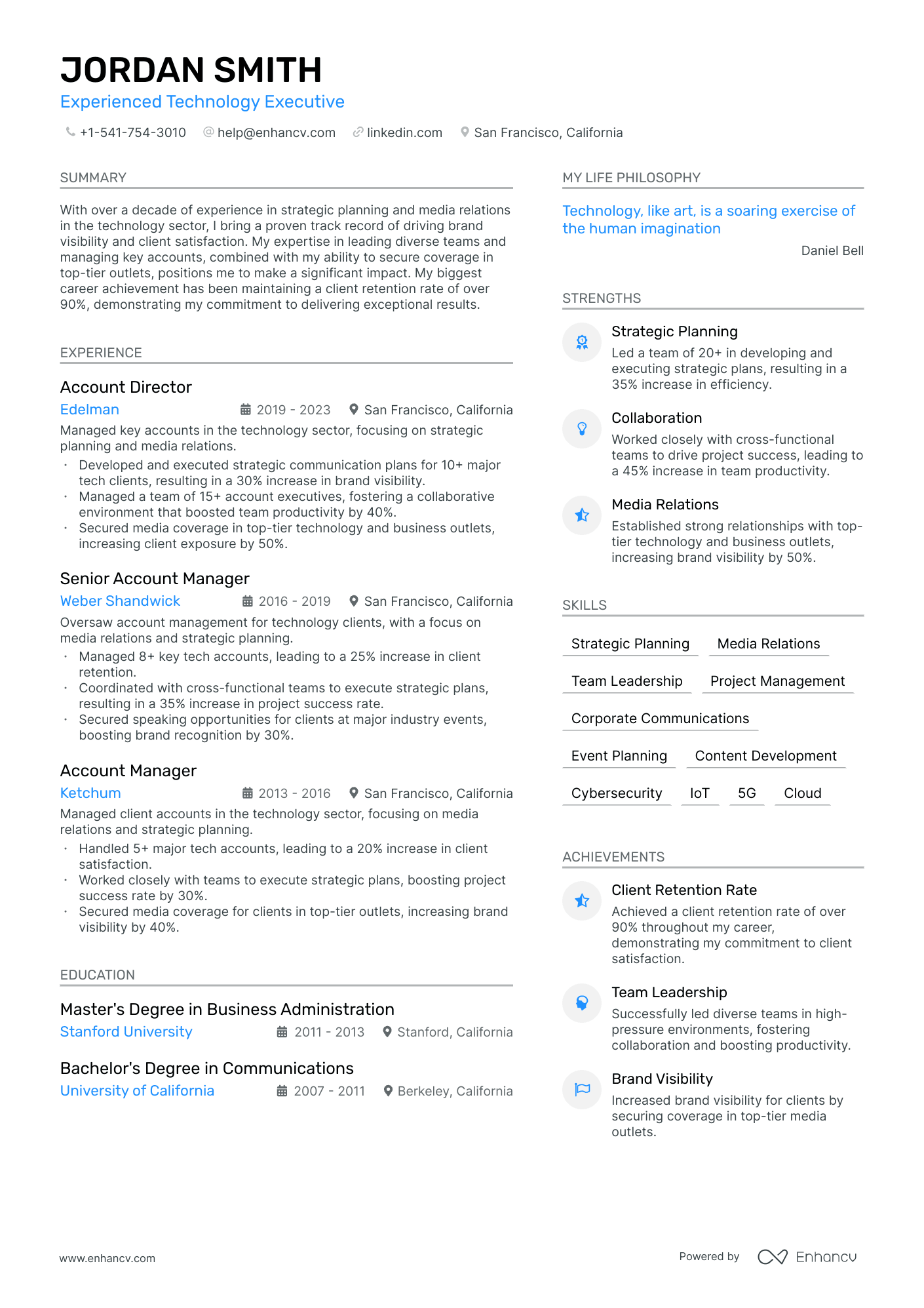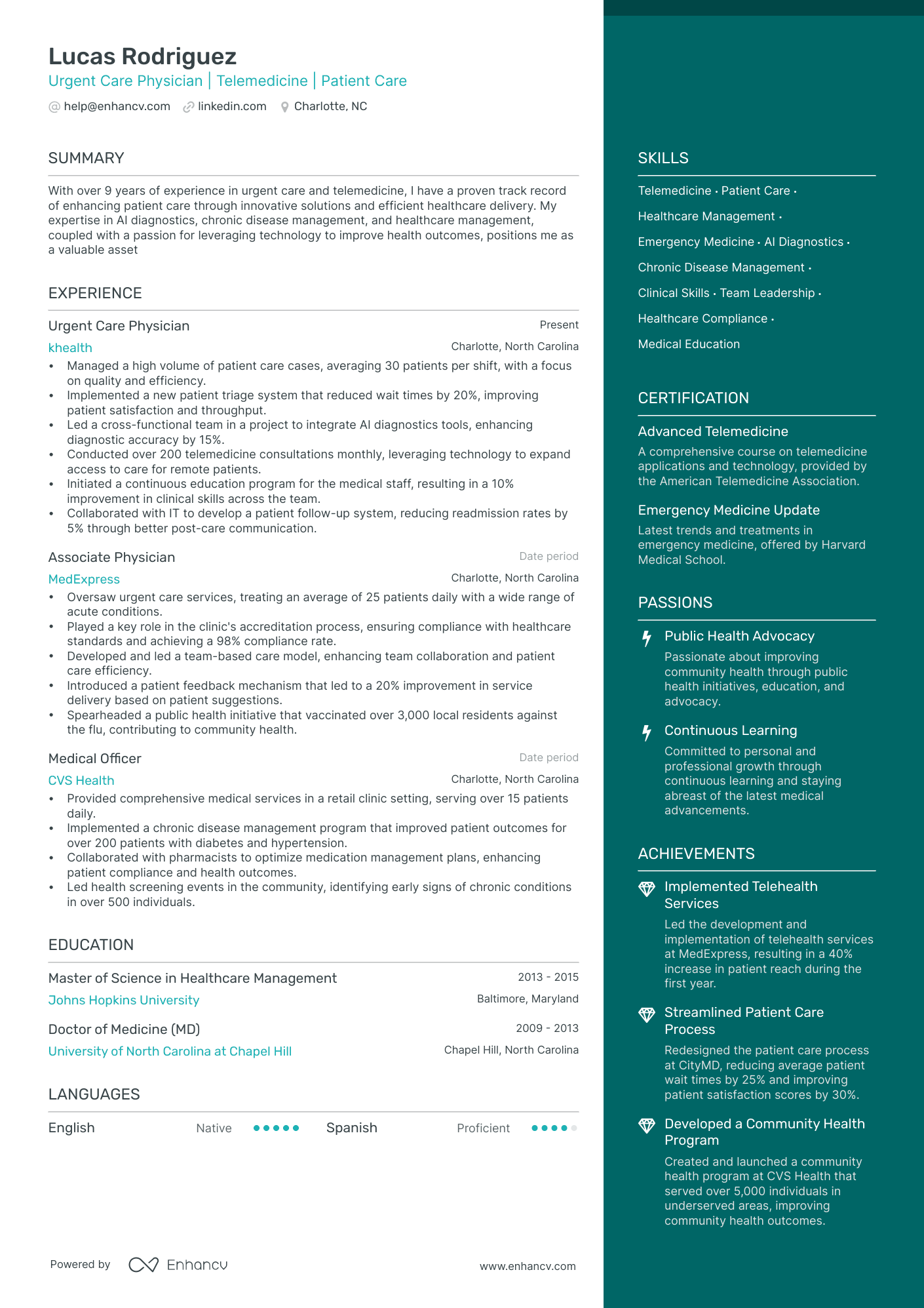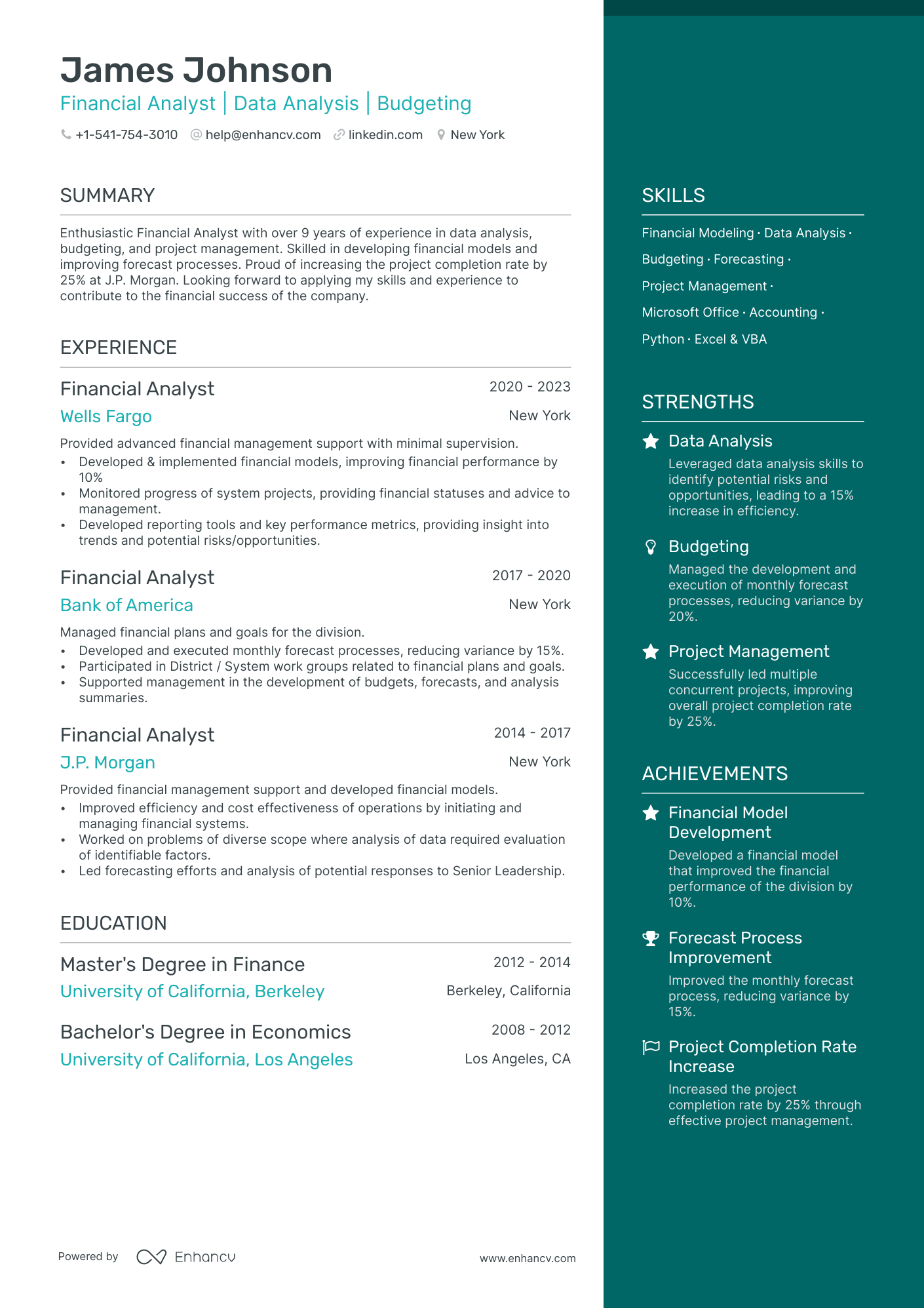The reverse chronological resume is the most common resume format out there, but is it impactful?
Today’s hiring landscape requires you to not only provide recruiters with information but to package it in a way that they remember. Especially when there’s a tsunami of applicants arriving at their desks.
Everyone is reduced to a piece of paper when it comes to resumes, so how can you make yoursas effective as possible?
See the benefits of the reverse-chronological resume and examples of how others have used it in their job application process below. Or explore our professionally designed chronological resume templates instead!
Is your resume good enough?
Drop your resume here or choose a file. PDF & DOCX only. Max 2MB file size.
What is the reverse chronological resume format?
The reverse-chronological resume describes the most recent job first and moves backward in time for every subsequent position.
The format comes with the following general expectation of flow:
- Resume header
- Personal summary
- Work experience
- Skills section
- Optional - any other relevant sections that make sense for the job you’re targeting. For example, projects, volunteering, or languages.
While this is the convention, it’s certainly not the law. You can keep the spirit of a reverse-chronological resume without sticking to a restricting structure. We’ll get into this further on in the article.
PRO TIP
Read our full guide about resume sections to confidently optimize a stronger resume that’s more likely to attract job recruiters!
What are the benefits of using a reverse chronological resume?
Going with a reverse chronological resume format can really boost your job application. This style has some great benefits that help show off your career growth and achievements in the best way possible. Here’s what a reverse chronological resume will help you achieve:
Provide a clear narrative of your career
Inconsistencies inyour career history are one of the first red flags recruiters will notice. Especially since recruiters spend just 6 seconds on initial screenings, your resume can easily be overlooked.
The recruiter is interested in the story of your career — including what brought you to this current position. This can play into your culture fit and your impact on the team dynamics within the organization.
To illustrate this, let’s see what Jonathan, one of Enhancv’s customers, wrote on his resume.
- •Logged over 1,000 incoming and outgoing food donations into the inventory database within the Logistics department.
- •Collaborated with 10+ beneficiary centers to project demand and prepare outgoing food pallets.
- •Partnered with 15 local businesses to initiate food donations and maintained relationships with current donors.
- •Compiled and analyzed performance and workload data for 50+ research centers across the country.
- •Produced fiscal year retrospective reports on trends and analyses and quarterly reporting of key performance metrics.
- •Prepared and participated in 10+ briefings for senior leadership of the Agency on performance trends.
- •Developed content and compiled a weekly electronic report distributed to over 500 employees, detailing upcoming events, deadlines, vacancy opportunities, and employee spotlights.
- •Served as confidential assistant to the Director, trusted with sensitive information, and engaged in discussions to improve team performance, streamline processes, and enhance operational efficiency of administrative service delivery.
When Jonathan was getting his job at HEB (one of the largest grocery retailers in Texas), he used the reverse-chronological order with Enhancv’s resume builder to highlight his journey into operations from data analytics. Because of this, job recruiters were able to estimate his skill level and recognize his commitment to the area.
Line up with recruiters’ expectations
Sometimes the traditional route is best. This can come into play when applying to large organizations with standardized application forms or those who rely on Automated Tracking Systems (ATS).
With the reverse-chronological resume being the most common, it’s easily analyzed by the ATS and gives recruiters exactly what they’re looking for. They can directly identify your most recent job and quickly assess how that experience compares to what you’ll be doing.
As the saying goes, “You’re only as good as your last performance”.
Have big names play in your favor
One of the advantages of using this format is that it emphasizes the organizations you’ve worked at previously. If you’ve worked with some heavy hitters in your industry, this can create a great impression on the hiring managers and separate you from the crowd.
- •Helped establish the Disney Cruise Line brand leading up to and including the maiden voyage of the Disney Magic.
- •Worked in partnership with Disney alliance partners (Coca-Cola, General Motors, American Express, et al) to achieve synergy as an extension of other Disney brands.
- •Selected to serve with elite Event Services division to coordinate and execute the press event for the 25th Anniversary of Walt Disney World.
- •Honored with prestigious Partners in Excellence award, internal recognition for top 2% Cast Members (employees) - the highest recognition within the Walt Disney Company.
Who is the reverse chronological resume for?
There are 4 common cases when you’d need to provide a reverse chronological overview of your experience. It’s best for:
- Professionals with a consistent work history: If you have a stable career progression, the chronological resume format highlights it, showing potential employers your growth and reliability over time.
- Individuals advancing in their career: If you're aiming for a higher position, the reverse-chronological resume style emphasizes your most recent roles and accomplishments, proving you're ready for the next step.
- Job seekers in the same industry: If you're staying within your field, this chronological format makes it simple for employers to track your career development and relevant experience.
- Students and recent graduates: If you're fresh out of school, this format showcases your latest achievements and education, making it easy for employers to see your most relevant experiences first. (Yes, even your education section entries should be listed in reverse chronological order).
Is the reverse chronological resume format right for you?
Your best bet would be to craft a resume using one of the other two formats to make your employment gaps less obvious. For example, the hybrid resume allows you to highlight your skills rather than your career progression, providing a good workaround.
We recommend avoiding this format if you're in an entry-level role or have mainly temporary work experience.
Just remember, whichever format you choose, list your experience, internships, education, and achievements in reverse chronological order.
Reverse chronological resume samples for 66 job titles
Below is a comprehensive list of jobs where the reverse chronological resume can best fit a candidate’s substantial experience.
Here are some job roles where this format is particularly advantageous:
- Senior executive (CEO, CFO, COO): For senior executives, a reverse chronological resume highlights an extensive career trajectory and leadership roles. It allows you to demonstrate your experience in managing companies, driving strategic initiatives, and leading large teams.
- Medical professional (doctor, surgeon, nurse): Medical professionals benefit from the reverse chronological format as it details their clinical experience, residency, and fellowship training. It also emphasizes your professional development and the increasing responsibility you’ve taken on over time.
- Academic (professor, research scientist): Academics and researchers often have a long history of positions, publications, and research projects. The reverse chronological resume allows you to showcase your educational background, academic appointments, and contributions to your field in a structured manner.
- Attorney (lawyer, legal counsel): Lawyers and legal professionals can use this format to outline their careers in the legal field, including positions held at different law firms, types of cases handled, and any significant legal victories.
- Engineer (civil, mechanical, electrical): You can benefit from this format as it highlights your technical experience, projects completed, and roles within various companies. It provides a clear timeline of your professional development, certifications, and advancements in your engineering career.
- Sales manager: Use a reverse chronological resume to demonstrate your sales achievements, leadership roles, and the progression of responsibilities. This format is ideal for showcasing a history of meeting or exceeding sales targets and managing sales teams.
- IT manager/director: IT professionals with extensive experience can use this format to highlight their roles in managing IT infrastructure and leading technology projects. It allows employers to see your growth and contributions to previous organizations.
- Marketing director: For this role, the reverse chronological resume helps to emphasize your experience in developing and executing marketing strategies, leading teams, and career growth within the marketing domain.
- Financial analyst: You can use this format to present your career progression, from entry-level analyst roles to senior positions.
- Operations manager: Operations managers benefit from a reverse chronological resume by detailing their roles in improving operational efficiency, managing logistics, and overseeing day-to-day operations. This format underscores your career development and achievements in optimizing business processes.
Here are the job titles by sector:
Accounting & finance
Business
Creative
Data science
Design
Engineering
- Engineering Resume
- Mechanical Engineer Resume
- Industrial Engineer Resume
- Product Engineer
- Automotive Engineer Resume
Executive and management roles
Foodservice and hospitality
- Chef Resume
- Restaurant Operations Manager Resume
- Hospitality Manager Resume
- Food and Beverage Manager Resume
Government and federal agencies
Human resources
Information technology
- Computer Science Resume
- Information Security Engineer Resume
- Software Engineer Resume
- Web Developer Resume
- Tech Resume
Law enforcement
Legal
Manufacturing
Marketing
Nursing and healthcare
Project management
Sales and retail
Science
Teaching and education
Quality assurance
Why is the reverse chronological resume format better?
The reason is relevance. On your resume, you should always prioritize experiences and skills directly related to the job you're applying for. Your most recent work experience provides a better reflection of your current qualifications than a job you did 5 years ago. The same applies to your educational progression.
By placing your latest experience at the top, you direct hiring managers’ attention to your most relevant achievements first. This allows them to quickly assess how well you’ll perform in the prospective job. Plus, this format ensures that the most pertinent and updated information is highlighted, making it easier for employers to see your fit for the role.
PRO TIP
Always tailor your resume to the job you’re applying for. Don’t list everything that comes to mind just to fill up space. Instead, select keywords from the job description and strategically incorporate them into your resume. This will help you pass the ATS screening and make it easier for recruiters to read through your document.
How to write a reverse chronological resume
You’ve probably seen a resume in reverse chronological order before—this is the most common type of resume and it's all over the internet. However, we’re here to give you some quick tips on how to craft yours step by step, along with some insider guidelines on mistakes to avoid.
The reverse chronological resume template should have the following sequence:
The top sections on a reverse chronological resume
- A clear and informative header that doesn’t leave recruiters guessing who’s applying for what.
- A compelling resume summary or objective that gives hiring managers an overview of your professional expertise and qualifications.
- A detailed and targeted resume experience section showing your fit for the role.
- A concise education section listing your most relevant academic accomplishments and certifications.
- A skills section showcasing the tools and techniques you’re most experienced in.
- An optional additional section with your top achievements, projects, or publications (whichever is most relevant to the job you’re targeting).
You may wonder what makes these sections so typical of the reverse chronological format. It’s the visual hierarchy they create on the resume. A clear and predictable organization makes it easier for recruiters to read and assess your qualifications, making them more relaxed and engaged with your resume.
Let’s tackle these sections one by one.
Resume header
The resume header is the section at the top of your resume and serves as the first point of contact for recruiters. It's often personalized with contrasting colors and a larger font size to attract attention. It should contain the following details:
- Contact information: State your name, job title, and location. Ensure your contact information is professional, including an email address.
- Links: Include a link to your professional portfolio or your LinkedIn profile.
- Resume photo: Generally, it’s best to omit photos to maintain focus on your qualifications and avoid potential biases.
Mistakes to avoid
Not making your name searchable. To make it easier for recruiters to find your resume in a sea of candidates, ensure your name matches your LinkedIn profile, the email address, and the file name.
Resume profile
A resume profile is a section that includes a brief overview of your previous experience, skills, and future goals related to a specific job opening. We normally distinguish between two types—a career summary and an objective statement. Here’s how to write yours:
- A short paragraph: Depending on your level of experience, write 3-5 sentences that highlight your best qualities, skills, and career goals. (Learn more about objective statements and how they differ from a resume summary).
- Choice of words: Use strong adjectives to describe yourself and start each sentence with a dynamic verb. Avoid writing in the first-person perspective.
- Finish up strong: Use the final sentence to reinforce your message. Make recruiters want to learn more about you.
Mistakes to avoid
Writing a resume summary or objective that’s too vague or generic. Ensure your profile is specific, tailored to the job you’re applying for, and highlights your unique qualifications and career goals.
Resume experience section
Your work history section determines the format of your resume. Senior candidates can benefit greatly from listing experience in reverse chronological order, while entry-level individuals should go for a hybrid or functional resume.
This is how your experience entries should be listed:
- Job title and company: Clearly state your most recent position and the company you worked for.
- Dates of employment: Include the month and year you started and ended each job. You also have the option of ticking “Ongoing” on the Enhancv’s resume builder.
- Job description: Optionally, add a short description of your role in the company, especially if it was a startup or an NGO—recruiters will need more context about it.
- Bullet points: Write 3-5 bullet points about your main tasks, duties, and contributions. Whenever possible, include numbers or statistics to illustrate your impact (e.g., increased sales by 20%, managed a team of 10).
- Relevant skills: Mention the skills you developed or used in each position that are pertinent to the job you’re applying for.
- Action verbs: Start each bullet entry with an action verb to showcase your initiative.
Mistakes to avoid
An experience section that doesn’t provide quantifiable results. Don’t just list job duties—include concrete numbers to make your impact tangible.
If you need a more detailed breakdown of how to build your experience section, dive into our article: How to List Work Experience on Your Resume—A Guide with Examples.
Resume education
Your education section also needs to follow a specific hierarchy to be more readable. See the steps below:
- Degree: Start with the highest degree you’ve obtained (e.g., Bachelor’s, Master’s, Ph.D.) and your major or field of study.
- University or college: Include the name of the institution where you earned your degree.
- Location: Mention the city and state (or country, if international) of the institution.
- Graduation date: Provide the month and year of your graduation. If you’re still studying, indicate your expected graduation date.
- Honors and awards: If applicable, list any honors, awards, or distinctions you received (e.g., summa cum laude, Dean’s List). If you’re fresh out of school, your GPA might come in handy, but only if it’s above 3.5.
- Relevant coursework: Optionally, include coursework relevant to the job you’re applying for, especially if you’re a recent graduate or changing careers.
Mistakes to avoid
Omitting important details. Make sure you include all critical information to ensure clarity and completeness.
Resume skills
Resume skills help potential employers identify whether you would be a good fit for the role. Consider the whole process from the recruiter's point of view. They’ll either briefly skim the document to identify relevant skills or work with ATS to identify them. Use the tips below to make your skills section count:
- Hard skills: If your job relies on software or specific tools, list your technical skills in a dedicated section on your resume.
- Soft skills: Unlike hard skills, which can be validated by certifications, soft skills are harder to prove. Integrate them into other resume sections and provide concrete examples of how you’ve demonstrated these skills.
- Relevance: Always prioritize listing skills that are specifically required in the job description.
Mistakes to avoid
Including irrelevant or generic skills that don’t align with the job you’re applying for. Always tailor your skills to match the job description, ensuring they’re specific and relevant to the position. This will make your resume more targeted and appealing to employers.
Additional sections
Depending on the job you’re applying for, inserting more sections into your resume can add value to your application.
- Space: Only add extra sections if you have enough space. A one-page resume is usually sufficient unless you have over 10 years of experience or are in a C-level position.
- Tailored approach: Choose sections based on the job requirements. For example, if you lack direct experience, you might include a “Hobbies & Interests” section to show how your leisure activities relate to the role.
- Common additional sections: Certifications, languages, and projects are often even mandatory for certain jobs. The key here is to include those that will strengthen your application the most.
Mistakes to avoid
Overloading with information and irrelevance. Providing too much detail can make the resume poorly targeted, lengthy, and difficult to read. Aim for conciseness and relevance.
Reverse chronological resume example — SEO Content Specialist
Reverse chronological resume example — IT Specialist
Reverse chronological resume example — Accountant
Reverse chronological resume example — Project Manager
Reverse chronological resume example — Product Manager
Reverse chronological resume example — Executives
Reverse chronological resume example — Doctor
Reverse chronological resume example — Financial Analyst
Reverse chronological resume template
[Your Name]
[Your City, State, ZIP] | [Your Phone Number] | [Your Email Address]
[LinkedIn Profile] | [Professional Website or Portfolio]
Professional summary
A concise summary highlighting your key qualifications, skills, and career goals. Typically 3-4 sentences.
Professional experience
[Most recent job title]
[Company Name], [City, State]
[Month/Year] – [Month/Year]
- Optional description.
- [Action verb] [your duty and/or accomplishment] [quantified results].
- [Action verb] [your duty and/or accomplishment] [quantified results].
- [Action verb] [your duty and/or accomplishment] [quantified results].
- [Action verb] [your duty and/or accomplishment] [quantified results].
[Previous job title]
[Company Name], [City, State]
[Month/Year] – [Month/Year]
- Optional description.
- [Action verb] [your duty and/or accomplishment] [quantified results].
- [Action verb] [your duty and/or accomplishment] [quantified results].
- [Action verb] [your duty and/or accomplishment] [quantified results].
- [Action verb] [your duty and/or accomplishment] [quantified results].
[Earlier job title]
[Company Name], [City, State]
[Month/Year] – [Month/Year]
- Optional description.
- [Action verb] [your duty and/or accomplishment] [quantified results].
- [Action verb] [your duty and/or accomplishment] [quantified results].
- [Action verb] [your duty and/or accomplishment] [quantified results].
- [Action verb] [your duty and/or accomplishment] [quantified results].
Education
[Degree Earned]
[University Name], [City, State]
[Month/Year] – [Month/Year]
- Relevant coursework: [Course Names]
- Honors and awards: [Any relevant honors or awards]
Certifications
- [Certification Name], [Issuing Organization], [Month/Year]
- [Certification Name], [Issuing Organization], [Month/Year]
Skills
- Technical skills: List relevant technical skills
- Hard skills: List role-specific practical skills
Additional sections
- Languages: List any languages spoken, if applicable.
- Professional affiliations
[Organization Name], Member since [Year]
[Organization Name], Member since [Year]
- Projects (if applicable)
[Project title]
[City, State] [Month/Year] – [Month/Year]
Description of responsibilities and achievements.
What’s at stake when using a reverse chronological resume?
Here are some of the considerations that pop into mind when creating a reverse chronological resume.
Gaps in your resume become more noticeable
“Do they still possess the same skills they had X years ago?” “Will they be able to adapt to the current market?”
These are just two of many possible questions the recruiter might not even spend the time to try and get an answer.
A chronological timeline will make the gaps in your career more apparent. If it's been a couple of years since your most recent job, that can be a red flag for the recruiter.
(Tip: One way to overcome this difficulty is to describe other projects or skills you’ve developed during the break.)
Harder to navigate through different sectors
Let’s say you have experience in both music and marketing. You’ve spent the last five years pursuing jobs in music, but now you’re looking for a new job in marketing.
In this case, it might make sense to use a reverse-chronological resume format. However, sticking to this structure could make your experience seem irrelevant. This makes it even harder for you, especially when you’re trying to move through the different areas that you’re skilled in.
(Tip: When building your resume, only select experience that’s relevant to the position you’re applying for).
Not optimal for first-time job seekers
With prior experience being the crux of this resume format, it’s going to be difficult to write your first resume in reverse chronological order. For this reason, this format is not suitable for those entering the job market or applying for volunteer positions for the first time.
(Tip: Go for a skills-based resume and make your strengths and talents shine through).
Chronological or reverse chronological resumes?
Chronological and reverse chronological resumes are often used interchangeably as they refer to the same format. They both mean listing your work experience starting from the most recent position and moving backward in time.
However, we use the more precise convention—reverse chronological—to avoid confusion.
The truth about reverse chronological resumes
This is a traditional format and it’s great for organizing your experience. Still, keep in mind that reverse chronological resumes are far from one-size-fits-all.
In reality, your resume should be tailored to the position you’re applying for. That’s what we call a targeted resume. This may mean starting with a less recent job first as long as it’s more pertinent to the prospective role.
With Enhancv’s resume builder, you can describe your previous experience in modular segments that can be moved as pieces to any place on your resume. This makes positioning easily streamlined, so you don’t have to worry too much.
Overall, you’ll benefit from organizing your resume by relevance and impact, not by date.
Reverse chronological vs functional vs combination format
Besides the reverse chronological resume, there are two other formats that suit different needs.
- The functional (skills-based) resume focuses on skills and experiences rather than a chronological work history, making it ideal for career changers or those with gaps in employment. You can put your skills section at the top, just below the resume summary, and provide relevant information about your strengths and abilities.
- The combination (or hybrid) resumeblends elements of both the reverse chronological and the functional formats, highlighting skills and achievements at the top, followed by a detailed work history. This format is great for showcasing relevant skills while also providing a clear employment timeline. It’s best for roles in project management, marketing, graphic design, and software development where a mix of technical and interpersonal skills is essential.
Take a look at the table below to see how the three formats compare to each other.
Key takeaways
Choosing the right resume format can make a huge difference in catching a recruiter’s eye. The reverse chronological resume is a popular choice for a reason, offering a clear and organized way to present your career history.
- Tells your career story: This format provides a straightforward timeline of your professional journey, making it easy for recruiters to see your growth and development.
- Recruiter-friendly: It’s a format that recruiters know well and can quickly scan, especially with the help of ATS.
- Showcases top employers: If you’ve worked for some big names, this format highlights those prestigious employers, helping you stand out.
- Perfect for stable careers: If you have a consistent work history, this format shows off your reliability and continuous growth.
- Great for moving up: It’s ideal for those looking to advance in their careers, as it emphasizes your most recent roles and achievements.
- Best for staying in the same field: If you’re sticking within your industry, this format makes it easy for employers to track your relevant experience.
- Good for new graduates: Even if you’re just out of school, this format can showcase your latest achievements and education, putting your most relevant qualifications front and center.
Make one that's truly you.





